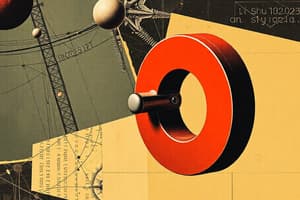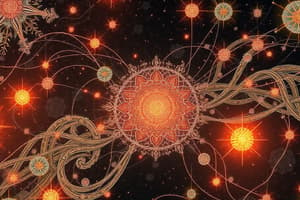Podcast
Questions and Answers
What happens to the force acting on a current-carrying conductor in a magnetic field if the direction of the current is reversed?
What happens to the force acting on a current-carrying conductor in a magnetic field if the direction of the current is reversed?
- The force decreases.
- The force remains the same.
- The force reverses direction. (correct)
- The force increases.
What is the purpose of a split-ring commutator in a DC motor?
What is the purpose of a split-ring commutator in a DC motor?
- To reduce the amount of current flowing through the coil.
- To ensure that the current flows in the same direction through the coil.
- To increase the speed of the motor.
- To reverse the direction of the current in the coil every half turn. (correct)
How can the turning effect of a DC motor be increased?
How can the turning effect of a DC motor be increased?
- Increasing the number of turns on the coil. (correct)
- Decreasing the current flowing through the coil.
- Decreasing the number of turns on the coil.
- Using a weaker magnetic field.
How does a loudspeaker produce sound?
How does a loudspeaker produce sound?
What is the relationship between the frequency of the alternating current flowing through a loudspeaker coil and the pitch of the sound produced?
What is the relationship between the frequency of the alternating current flowing through a loudspeaker coil and the pitch of the sound produced?
When will a force be exerted on a charged particle moving in a magnetic field?
When will a force be exerted on a charged particle moving in a magnetic field?
How is a voltage induced in a conducting wire?
How is a voltage induced in a conducting wire?
What is the main difference between the magnetic field created by a solenoid and a flat circular coil?
What is the main difference between the magnetic field created by a solenoid and a flat circular coil?
What will happen when two like poles of magnets are brought close together?
What will happen when two like poles of magnets are brought close together?
Which of the following materials cannot be magnetized?
Which of the following materials cannot be magnetized?
What characterizes magnetically hard materials?
What characterizes magnetically hard materials?
What do closely spaced magnetic field lines indicate?
What do closely spaced magnetic field lines indicate?
How does an electric current affect a conductor?
How does an electric current affect a conductor?
Which statement about electromagnets is true?
Which statement about electromagnets is true?
What does the right-hand grip rule help determine?
What does the right-hand grip rule help determine?
Which type of magnetic materials are described as magnetically soft?
Which type of magnetic materials are described as magnetically soft?
What is the effect of increasing the length of wire inside a magnetic field?
What is the effect of increasing the length of wire inside a magnetic field?
How can the voltage induced in a coil by a changing magnetic field be increased?
How can the voltage induced in a coil by a changing magnetic field be increased?
What is the purpose of a step-up transformer in the context of power lines?
What is the purpose of a step-up transformer in the context of power lines?
What is the relationship between the number of turns in the primary and secondary coils of a step-down transformer?
What is the relationship between the number of turns in the primary and secondary coils of a step-down transformer?
Which of the following actions would NOT increase the induced voltage in a coil?
Which of the following actions would NOT increase the induced voltage in a coil?
What is the role of a transformer in the transmission and distribution of electricity?
What is the role of a transformer in the transmission and distribution of electricity?
How can the voltage be increased when rotating a coil in a magnetic field?
How can the voltage be increased when rotating a coil in a magnetic field?
What is meant by the term "generator effect"?
What is meant by the term "generator effect"?
Flashcards
Magnetism
Magnetism
The phenomenon where magnets repel and attract each other or magnetic materials.
Magnetic materials
Magnetic materials
Materials that are attracted to magnets and can be magnetised, such as iron and nickel.
Non-magnetic materials
Non-magnetic materials
Materials that are not attracted to magnets and cannot be magnetised, e.g., glass.
Magnetic induction
Magnetic induction
Signup and view all the flashcards
Magnetically hard materials
Magnetically hard materials
Signup and view all the flashcards
Magnetically soft materials
Magnetically soft materials
Signup and view all the flashcards
Magnetic field lines
Magnetic field lines
Signup and view all the flashcards
Right-hand grip rule
Right-hand grip rule
Signup and view all the flashcards
Generator Effect
Generator Effect
Signup and view all the flashcards
Induced Voltage
Induced Voltage
Signup and view all the flashcards
Factors to Increase Voltage
Factors to Increase Voltage
Signup and view all the flashcards
Alternating Voltage
Alternating Voltage
Signup and view all the flashcards
Transformer
Transformer
Signup and view all the flashcards
Step-Up Transformer
Step-Up Transformer
Signup and view all the flashcards
Step-Down Transformer
Step-Down Transformer
Signup and view all the flashcards
Coil Rotation
Coil Rotation
Signup and view all the flashcards
Solenoid
Solenoid
Signup and view all the flashcards
Motor Effect
Motor Effect
Signup and view all the flashcards
Fleming's Left-Hand Rule
Fleming's Left-Hand Rule
Signup and view all the flashcards
DC Motors
DC Motors
Signup and view all the flashcards
Turning Effect
Turning Effect
Signup and view all the flashcards
Split Ring Commutator
Split Ring Commutator
Signup and view all the flashcards
Electromagnetic Induction
Electromagnetic Induction
Signup and view all the flashcards
Alternating Current (AC)
Alternating Current (AC)
Signup and view all the flashcards
Study Notes
Magnetism
- Magnets attract or repel other magnets and magnetic materials. Like poles repel, and opposite poles attract.
- Non-magnetic materials are not attracted to magnets and cannot be magnetized (e.g., glass, plastic).
- Magnetic materials are attracted to magnets and can be magnetized (e.g., iron, steel, cobalt, nickel).
- Magnetism can be induced in magnetic materials by placing them in a magnetic field.
- Magnetically hard materials can be permanently magnetized (e.g., steel).
- Magnetically soft materials are only temporarily magnetized (e.g., soft iron).
- Magnetic field lines represent the magnetic force on a north pole at a given point. The direction of a magnetic field line shows the direction of the force. The closer the field lines are to each other, the stronger the force.
- Field lines from magnets point from north to south.
- Between opposite poles of magnets placed close together, the field is uniform, the field lines are parallel and evenly spaced.
Electromagnetism
- An electric current passing through a conductor produces a magnetic field around it.
- Electromagnets consist of a coil of wire wrapped around a magnetically soft core; they can be turned on and off.
- The right-hand grip rule determines the direction of the magnetic field produced by a current-carrying wire.
- The magnetic field created by a solenoid (a coil of wire) is similar to that of a bar magnet.
- The magnetic field created by a flat circular coil has a specific pattern.
DC Motors
- DC motors have a coil of wire in a magnetic field.
- Current flows through the wire, creating forces that cause the coil to turn.
- Increasing the current, using a stronger magnetic field, or increasing the number of turns on the coil increases the turning effect.
- A split-ring commutator reverses the current every half-turn, ensuring continuous rotation.
Loudspeakers
- Loudspeakers use a coil attached to a cone in a magnetic field.
- Alternating current causes the cone to move, producing sound.
- Changing the alternating current changes the frequency of the sound.
Electromagnetic Induction
- Movement between a conductor and a magnetic field induces a voltage.
- This effect, known as electromagnetic induction, can be used to generate electricity. Factors affecting the induced voltage and current are increased speed, strength of the magnetic field, or size of the loops of the conductor in the field.
Transformers
- Transformers use two coils wrapped around a soft iron core to change voltage.
- A step-up transformer increases voltage, while a step-down transformer decreases voltage.
- The ratio of the number of turns in the primary coil to the number of turns in the secondary coil determines the voltage ratio.
- Transformers are used to transmit electrical power efficiently over long distances.
Studying That Suits You
Use AI to generate personalized quizzes and flashcards to suit your learning preferences.




